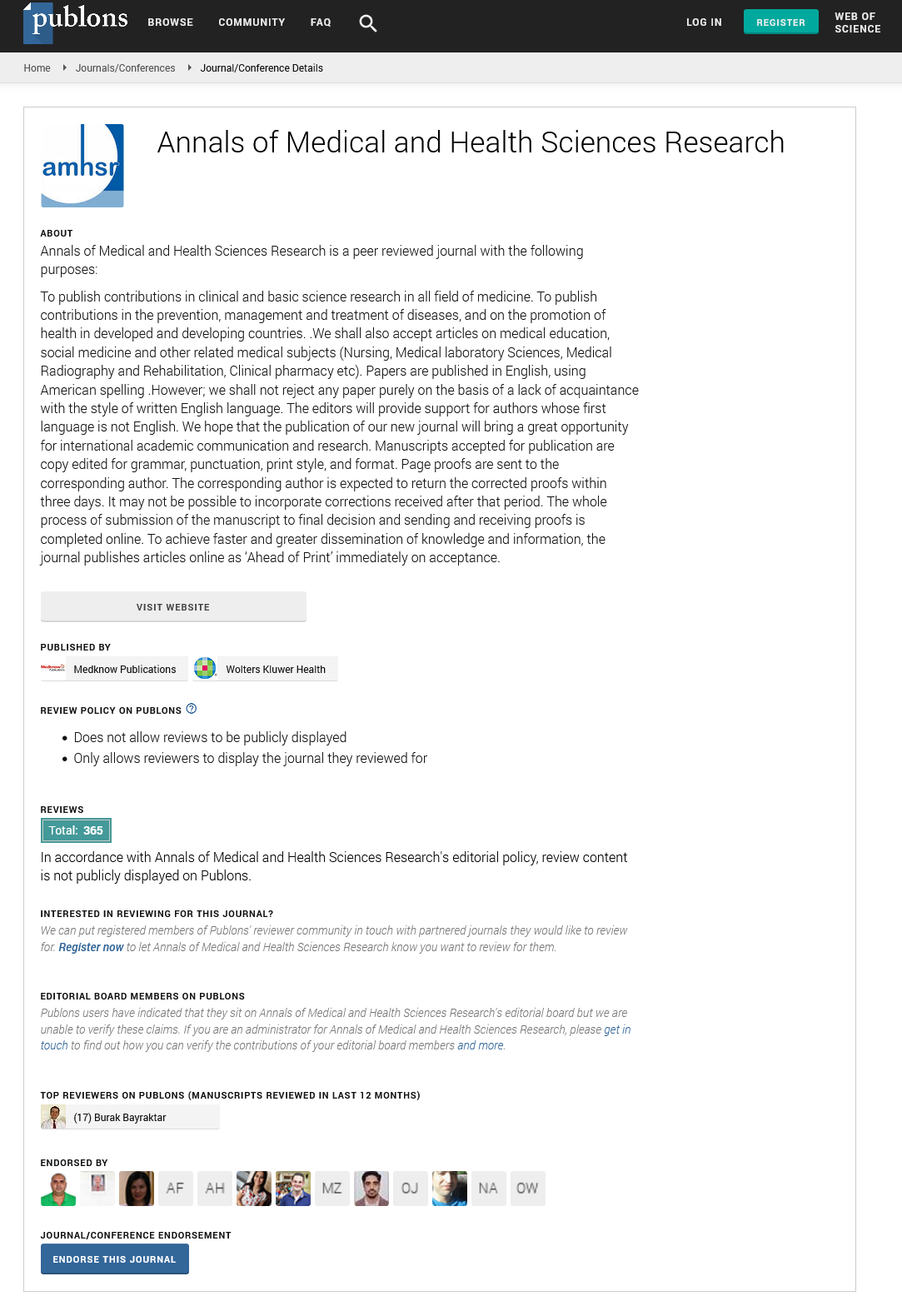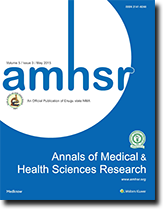Chimeric Antigen Receptor T-Cell Therapy in Systemic Lupus Erythematosus and Lupus Nephritis; A Promising Approach to Targeting Autoreactive B Cells
2 Department of Community Health Sciences, Jinnah Medical and Dental College, Karachi, Pakistan
3 Department of Medical Sciences, Liaquat University of Medical and Health Sciences, Jamshoro, Pakistan
4 Department of Medical Sciences, University Hospital Limerick, Limerick, Ireland
5 Department of Medical Sciences, Jinnah Sindh Medical University, Karachi, Pakistan
6 Department of Medicine, Bahcesehir University, Istanbul, Turkey
7 Department of Medical Sciences, King Edward Medical University, Lahore, Pakistan
Received: 04-Sep-2024, Manuscript No. AMHSR-24-147274; Editor assigned: 09-Sep-2024, Pre QC No. AMHSR-24-147274 (PQ); Reviewed: 24-Sep-2024 QC No. AMHSR-24-147274; Revised: 15-Apr-2025, Manuscript No. AMHSR-24-147274 (R); Published: 22-Apr-2025
Citation: Maheshwari C, et al. Chimeric Antigen Receptor T-Cell Therapy in Systemic Lupus Erythematosus and Lupus Nephritis; A Promising Approach to Targeting Autoreactive B Cells. Ann Med Health Sci Res. 2025;15:1-4
This open-access article is distributed under the terms of the Creative Commons Attribution Non-Commercial License (CC BY-NC) (http://creativecommons.org/licenses/by-nc/4.0/), which permits reuse, distribution and reproduction of the article, provided that the original work is properly cited and the reuse is restricted to noncommercial purposes. For commercial reuse, contact reprints@pulsus.com
Abstract
Systemic Lupus Erythematosus (SLE) poses significant challenges due to its life-threatening nature and the prevalence of lupus nephritis, which causes serious kidney damage. Traditional therapies, such as immunosuppressive medications and blocking antibodies, have had limited success, necessitating the development of novel therapeutic strategies. Chimeric Antigen Receptor T-cell therapy (CAR-T) targets autoreactive B cells and reduces disease activity, and offers promising results for improving disease outcomes, improving survival, and decreasing morbidity and mortality. In this review article, we aim to highlight the potential of CAR-T cell therapy in treating the autoimmune processes that underlie SLE and lupus nephritis.
This review article investigates and assesses the indings, usage in treating diseases and predicting its future consequences. We examine current studies and clinical trials that demonstrate the efficacy of CAR-T cell therapy in refractory instances of SLE, emphasizing its potential as a game-changing treatment option.
Keywords
Autoimmune; Therapy; Nephritis; Hypertension; SLEIntroduction
SLE (Systemic Lupus Erythematosus) is a severe autoimmune disease which mostly affects young women. It is characterized by adaptive immunological activation and elevated DsDNA antibody levels [1-3]. SLE has a wide range of symptoms and problems, the most common and serious of which is lupus nephritis. Lupus nephritis is identified in 15-30% of SLE patients at the time of diagnosis, and 30-50% develop as the disease progresses. Lupus nephritis symptoms vary, but may include fatigue, hypertension, edema, proteinuria, and abnormal kidney function tests. Nephritis is characterized by severe kidney damage in SLE patients, which can result in severe morbidity and mortality owing to renal failure [1,2]. Renal biopsy is typically used to confirm the diagnosis, determine the therapy mode, and assess treatment efficacy [1,2].
Lupus nephritis has a Standard Mortality Rate (SMR) of 4.689 which is significantly worse than cardiovascular events (SMR of 2.253) and infectious etiologies and complications (SMR of 4.980) [4]. Medical treatment options include corticosteroids, ACE inhibitors, ARBs, diuretics, immunosuppressant, beta blockers, and calcium channel blockers. The immunosuppressive drugs and blocking antibodies are the backbone for treating autoimmune diseases but they are usually not curative. Hence, there is a need for new treatment modalities to address this widespread health concern that is causing increased mortality and morbidity [4].
CAR-T cell therapy (also known as adoptive cell transfer) involves collecting T cells from patients and reengineering them in the laboratory to develop proteins on their surface that detect autoreactive cells, which are known as chimeric antigen receptors. They are allowed to expand in vivo before being injected back into the patient’s blood to increase therapy efficacy. Each type of CAR-T cell treatment is designed to target a certain type of antigen or surface protein on an immune cell. CAR-T cell therapy has been approved by the FDA to treat a variety of blood malignancies, including leukemia, lymphoma, and multiple myeloma. CAR-T cell therapy is being utilized as a potential treatment for SLE, lupus nephritis, myasthenia gravis, and antisynthetase syndrome [5,6].
Literature Review
CARs are synthetic modules made up of functional receptors that typically include components such as an antigen recognition domain, a T cell co-stimulation domain, and a CD3 T cell activation domain. The expression of the CAR receptor on T cells realigns their function through a combination of tumor selectivity and a powerful cytotoxic immune response. According to earlier clinical trials, CART showed an excellent response in 90% of single-center trials and 70-80% of multicenter trials in patients suffering from acute lymphoblastic leukemia. CRS is a serious complication defined by a wide range of reactions caused by the immune system's rapid activation. Symptoms may appear immediately or later because of the immune system's rapid activation which can result from target-based antigen-driven T cells [7].
Discussion
Pathogenesis
The etiology of lupus nephritis centers around the aberrant activation of autoreactive B cells; as a result, several studies of B cell depletion by antibodies have been conducted, although their therapeutic success is limited [8,9]. It could be attributed to the continued accessibility and persistence of autoreactive B cells in lymphatic organs and inflammatory tissues, though some resources suggest that the additional role of CD20 negative plasma cells, which are an additional source of autoantibodies in lupus patients, could be another source of unresolved disease treatment [3,6,8-10]
To address these additional autoantibodies, new treatment modalities have been devised, including the use of genetically engineered chimeric antigen receptor modified T cells that recognize CD19 cells and other B cell surface antigens responsible for this autoimmune disease, which has recently emerged as a significant treatment tool for treating relapsed or refractory B cell cancers and lymphomas, and is being employed and contemplated to be used in treating patients [3,6,11].
Efficacy of CAR-T cell therapy
Several trials are being conducted, including one involving a 20-year-old woman who had a severe refractory case of SLE and presented with a class 3A level of active lupus nephritis, reflecting focal proliferative disease with active lesions on renal biopsy, as well as the signs and symptoms of pericarditis, pleuritis, rash, arthritis, and lib-man sacks endocarditis. She had previously been treated with hydroxychloroquine, high-dose glucocorticoids, tacrolimus, and specialized medicines that target B cells such as belimumab and rituximab, which did not provide her with relief or reduce the number of autoreactive B cells. Then trial of CAR-T cell therapy infusion was begun after refraining from all other treatment modalities and only using minimal doses [3,6]. CD19 CAR-T cells were generated by lentiviral transduction of autologous leukapheresis. They were treated with fludarabine and cyclophosphamide to reduce their lymphocytes. In vivo, the number of CAR-T cells expanded rapidly in the next days, and the patient’s symptoms alleviated without any noticeable adverse effects associated with CART cell therapy, such as cytokine release syndrome, neurotoxic consequences, or persistent cytopenia [3,6]. With expanded CART cell therapy, circulating B cells reduced considerably from 5000 U per ml to 4 U per ml over a 5- week period, and low C3 and C4 levels returned to normal. The patient experienced significant clinical improvement in terms of proteinuria, and her SELENA (Safety of Estrogens in Lupus National Assessment) score dropped from 16 at baseline to 0 at follow-up. It has been established that the drop in DsDNA is due to CD19-expressing plasmablasts being the primary source of these autoantibodies [3,6].
Capperll et al., reported the use of the CAR-T cell therapy in four women and one man who were in their middle age when diagnosed with refractory SLE and unresponsive to immunosuppressants and other therapeutic options [1,2]. CART cell therapy was an effective therapy in this group of patients, resulting in considerable improvements and normalization of laboratory indicators, as well as a noticeable decrease in DsDNA antibodies. These individuals responded effectively to CART cell treatment and demonstrated complete SLE remission according to the DORIS criteria [1,2,12].
This important data demonstrates that CD19 cell transfer therapy can be a successful therapeutic adjustment for SLE patients. The FDA has approved two CD19 CART cell preparations for treating SLE and its associated complications with medications called tisagenlecleucel and axicabtagene ciloleucel and some ongoing trials for new patients are still pending [1-3,6,7,12].
Cappell, et al. [1] Chou, et al. [12] reported another case series that involved the evaluation of 15 patients, among which 8 had severe SLE, 3 had myositis, and 4 had systemic sclerosis. Following a single infusion of CD19 CAR-T cells, all of the SLE patients showed DORIS [1,2,12] remission after approximately 145 months on follow-up, and all of the myositis patients showed ACR-EULAR major clinical response. In a similar pattern, the patients with systemic sclerosis showed a decline in their EUSTAR activity index score [2,3,6,9].
It all hinges on the T cell's interaction with a target antigen, followed by proliferation and a functional response. Other probable factors include the type of disease, the nature and design of lymphodepletion, and perhaps the CART design. Four out of seven patients with ALL, including children and young adults, received CART targeting CD22 T cells. Similarly, CRS was seen in patients with multiple myeloma that targeted the CD19 or B cell antigen. IL6 is the primary mediator of CRS, however IFN gamma, GM-CSF, IL5, and IL8, IL10 may also play an important role [13,14].
So, if we successfully block the IL6 receptor, we can reduce the occurrence and severity of CRS. This was implied in a clinical experiment aimed at inhibiting the IL6 receptor in an ALL patient who regrettably developed CRS [13]. Tocilizumab is an IL6 receptor antagonist [7,13,14].
Side effects of CAR-T cell therapy
While CAR-T cell therapy presents significant benefits, it is important to acknowledge potential side effects including Cytokine Release Syndrome (CRS) and neurotoxicity. The most prevalent complication linked with CAR-T cell therapy is CRS which also includes cytopenias and hypogammaglobulinemia. Most patients experience minor CRS, which manifests as a flu-like sickness with fever and myalgias. However, in rare cases, it can produce a severe reaction that includes vascular leak, hypotension, pulmonary edema, and coagulopathy, as well as multiorgan failure. Corticosteroids have been shown to be effective in terminating or preventing CRS and other related problems such as graft vs. host disease or other inflammatory diseases [9,14].
These adverse effects, influenced by factors like disease severity and treatment dosage, can be managed with interventions such as immunosuppressants and corticosteroids. However, with appropriate precautions and treatment strategies in place, the efficacy of CD-19 CAR-T cell therapy remains undeniable, as evidenced by clinical trials and data [9].
Patients who got blinatumomab, [14] a CD3/CD19 inhibitor, experienced a delayed CRS reaction. The method of administering blinatumomab is intended to prevent or reduce the risk of CRS. A recent study on 189 patients utilizing blinatumomab was undertaken, and efforts were taken to prevent CRS by administering dexamethasone in prephase, particularly in patients with a high tumor burden, and within one hour of beginning treatment in each cycle [14]. The ability to withdraw or at least regulate the drug before CRS occurrence, as well as the use of CTCAE grading and therapeutic potency, have all contributed to the low rate of CRS occurrence. CRS with CART infusion is dependent on the tumor burden. CRS can develop after 1-14 days of CAR-T Cell infusion or, in rare cases, beyond 12 days (Table 1) [7,13,14].
| Table 1: Common side effects of CAR-T cell therapy and their treatment. | ||
|---|---|---|
| Side effects | Symptoms | Treatment |
| Cytokine release syndrome | Fever, myalgias, headache, anorexia, nausea and vomiting, renal dysfunction, coagulopathy, hypotension, capillary leak, and pulmonary edema | Acetaminophen, narcotics, total parenteral nutrition, antiemetics, renal dosing of medication to dialysis, fresh frozen plasma, cryoprecipitate, platelets, vasoactives, tocilizumab, methylprednisone, oxygen support, and intubation. |
| Graft-versus-host disease | Rash, diarrhea, and hyperbilirubinemia | Topical triamcinolone and possible systemic treatments with calcineurin inhibitors or steroids (only in discussion with CAR-T cell therapy team) |
| Neurologic symptoms | Confusion, B-cell aphasia, unresponsiveness and seizures | Supportive care (e.g., Reorientation, antiepileptics) |
| Tumor lysis syndrome | Hyperuricemia, hyperkalemia hyperphosphatemia, and hypocalcemia | Allopurinol and hydration |
Conclusion
CAR-T cell treatment is a unique and promising method to treat refractory SLE and lupus nephritis. CAR-T cell therapy targets autoreactive B cells and modulates underlying autoimmune processes. It has a potential to improve disease activity and renal function in SLE patients. However, more studies are needed to improve treatment procedures, assess long-term efficacy and safety.Conflicts of Interest
None declared.Disclaimer
None to be declared.Author Contribution
All the authors contributed equally in drafting, editing, revising and finalizing the manuscript.Ethical Approval
The ethical approval was not required for the article as per the countryâ??s guidelines.Funding Disclosure
None to be declared.Data Availability Statement
None to be declared.References
- Cappell KM, Kochenderfer JN. Long-term outcomes following CAR-T cell therapy: What we know so far. Nat Rev Clin Oncol. 2023;20(6):359-371.
[Crossref] [Google Scholar] [PubMed]
- Mackensen A, Müller F, Mougiakakos D, Böltz S, Wilhelm A, et al. Anti-CD19 CAR-T cell therapy for refractory systemic lupus erythematosus. Nat Med. 2022;28(10):2124-2132.
[Crossref] [Google Scholar] [PubMed]
- Porter DL, Levine BL, Kalos M, Bagg A, June CH. Chimeric antigen receptor–modified T cells in chronic lymphoid leukemia. N Engl J Med. 2011;365(8):725-733.
[Crossref] [Google Scholar] [PubMed]
- Lee YH, Choi SJ, Ji JD, Song GG. Overall and cause-specific mortality in systemic lupus erythematosus: An updated meta-analysis. Lupus. 2016;25(7):727-734.
[Crossref] [Google Scholar] [PubMed]
- Kansal R, Richardson N, Neeli I, Khawaja S, Chamberlain D, et al. Sustained B cell depletion by CD19-targeted CAR-T cells is a highly effective treatment for murine lupus. Sci Transl Med. 2019;11(482):eaav1648.
[Crossref] [Google Scholar] [PubMed]
- Müller F, Taubmann J, Bucci L, Wilhelm A, Bergmann C, et al. CD19 CAR-T cell therapy in autoimmune disease-a case series with follow-up. N Engl J Med. 2024;390(8):687-700.
[Crossref] [Google Scholar] [PubMed]
- Singh JA, Beg S, Lopez-Olivo MA. Tocilizumab for rheumatoid arthritis: A cochrane systematic review. J Rheumatol. 2011;38(1):10-20.
[Crossref] [Google Scholar] [PubMed]
- Hirayama AV, Turtle CJ. Toxicities of CD19 CARâ?T cell immunotherapy. Am J Hematol. 2019;94(S1):S42-S49.
[Crossref] [Google Scholar] [PubMed]
- Merrill JT, Neuwelt CM, Wallace DJ, Shanahan JC, Latinis KM, et al. Efficacy and safety of rituximab in moderatelyâ?toâ?severely active systemic lupus erythematosus: the randomized, doubleâ?blind, phase II/III systemic lupus erythematosus evaluation of rituximab trial. Arthritis Rheum. 2010;62(1):222-233.
[Crossref] [Google Scholar] [PubMed]
- Boulougoura A, Gendelman H, Surmachevska N, Kyttaris VC. Journal Club: Antiâ?CD19 chimeric antigen receptor T cell therapy for refractory systemic lupus erythematosus. ACR Open Rheumatol. 2023;5(11):624-628.
[Crossref] [Google Scholar] [PubMed]
- Qin C, Dong MH, Zhou LQ, Wang W, Cai SB, et al. Single-cell analysis of refractory anti-SRP necrotizing myopathy treated with anti-BCMA CAR-T cell therapy. Proc Natl Acad Sci USA. 2024;121(6):e2315990121.
[Crossref] [Google Scholar] [PubMed]
- Chou CK, Turtle CJ. Assessment and management of cytokine release syndrome and neurotoxicity following CD19 CAR-T cell therapy. Expert Opin Biol Ther. 2020;20(6):653-664.
[Crossref] [Google Scholar] [PubMed]
- Maude SL, Barrett D, Teachey DT, Grupp SA. Managing cytokine release syndrome associated with novel T cell-engaging therapies. Cancer J. 2014;20(2):119-122.
[Crossref] [Google Scholar] [PubMed]
- Topp MS, Kufer P, Gökbuget N, Goebeler M, Klinger M, et al. Targeted therapy with the T-cell–engaging antibody blinatumomab of chemotherapy-refractory minimal residual disease in B-lineage acute lymphoblastic leukemia patients results in high response rate and prolonged leukemia-free survival. J Clin Oncol. 2011;29(18):2493-2498.
[Crossref] [Google Scholar] [PubMed]




 The Annals of Medical and Health Sciences Research is a monthly multidisciplinary medical journal.
The Annals of Medical and Health Sciences Research is a monthly multidisciplinary medical journal.